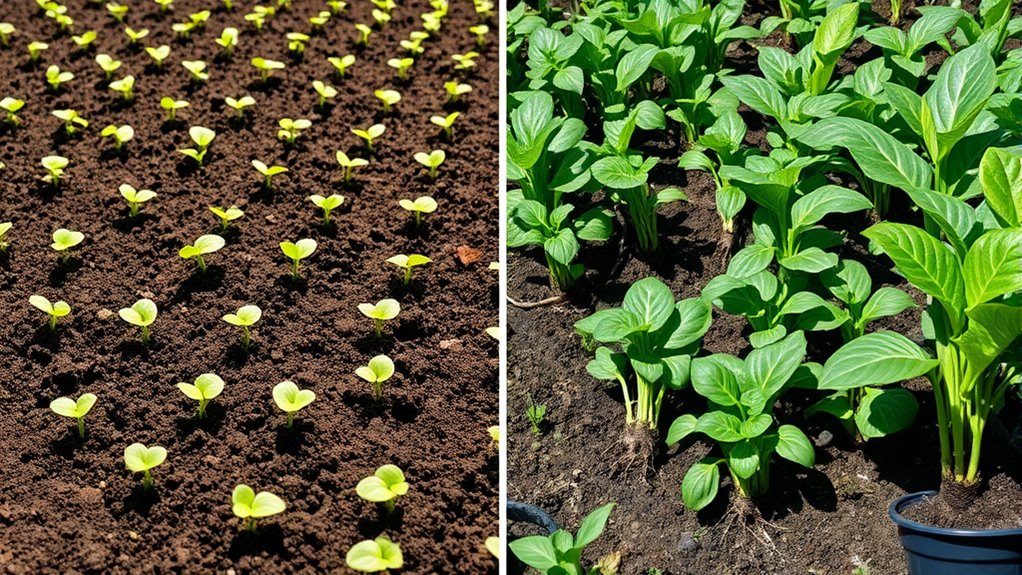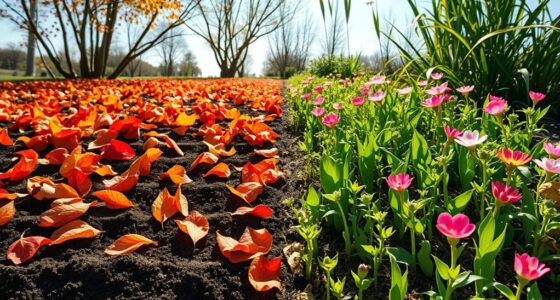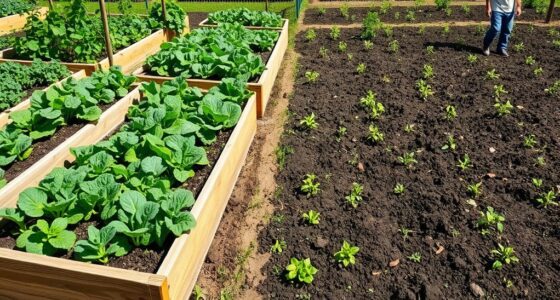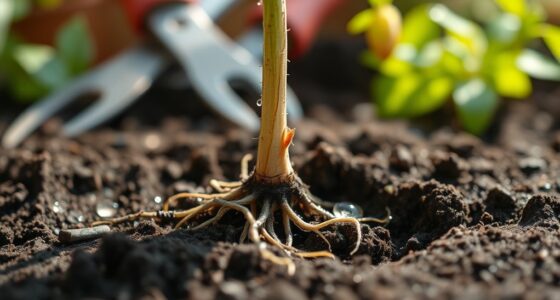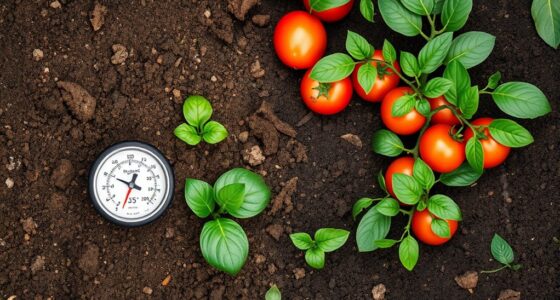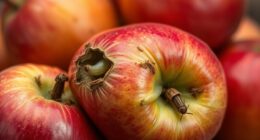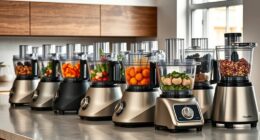Choosing between direct sowing and transplants depends on your vegetable types, climate, and resources. Direct sowing works well for hardy crops like carrots and beans, saving time and effort. Transplants are better for plants that need a head start, like tomatoes and peppers, especially if you have a shorter growing season. Understanding the pros and cons can help you optimize your garden’s success—continue to discover helpful tips for each method.
Key Takeaways
- Direct sowing is ideal for hardy crops like carrots and beans, while transplants benefit delicate or slow-growing vegetables like tomatoes and peppers.
- Transplants allow for an earlier start and extended growing season, whereas direct sowing reduces initial labor and root disturbance.
- Proper soil preparation and pest management are crucial for both methods to ensure healthy plant development.
- Transplants involve more initial effort and cost but can lead to faster establishment and higher success rates.
- Choosing between methods depends on crop type, climate, and available resources for optimal vegetable production.
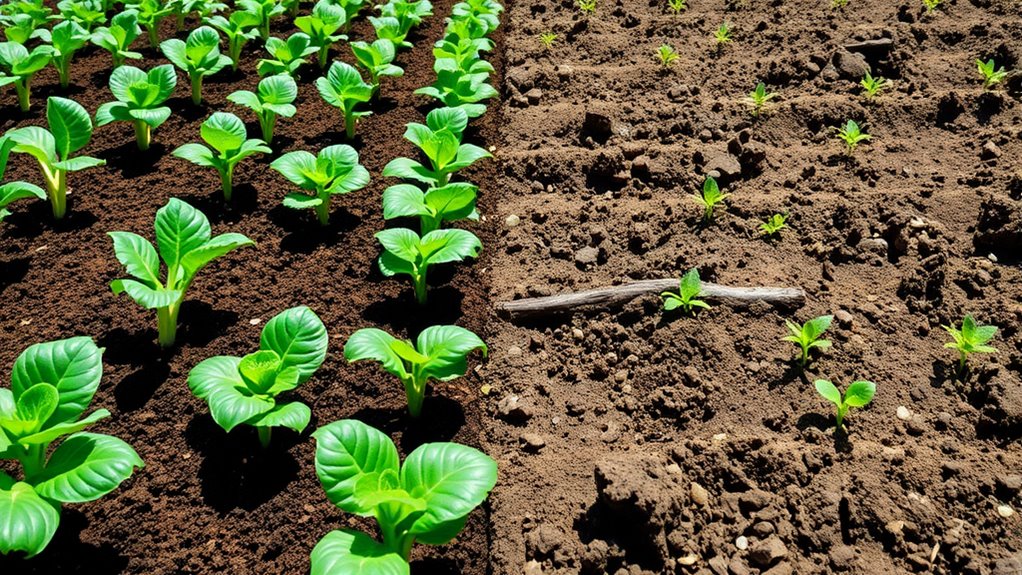
Growing vegetables successfully begins with choosing the right planting methods. One of the most important decisions you’ll make is whether to sow your seeds directly into the ground or start them indoors as transplants. Both methods have their advantages, but they also demand specific approaches to soil preparation and pest management to guarantee healthy growth.
Choosing the right planting method is key to successful vegetable gardening.
If you opt for direct sowing, you’re planting seeds straight into your garden bed. Before doing so, you need to prepare the soil thoroughly. Clear out weeds and debris, then loosen the soil to improve aeration. Mixing in organic matter like compost boosts soil fertility and helps retain moisture, which is essential for seed germination. Proper soil preparation reduces the risk of pests by creating a healthy environment that encourages strong root development. Healthy plants are less vulnerable to pests and diseases, so maintaining good soil conditions is a key step. Keep the soil consistently moist during germination, but avoid overwatering, as overly wet soil can attract pests like fungus gnats and promote disease. Additionally, monitoring for signs of spoilage or contamination, such as mold or unusual odors, ensures your seeds are healthy before planting.
Transplants, on the other hand, involve starting seeds indoors or purchasing young plants from nurseries, then moving them into your garden once they’re well-established. When transplanting, you need to pay attention to soil preparation at the planting site. Make sure the soil is loose, rich in nutrients, and free of pests that could attack young plants. It’s wise to inspect the roots of your transplants for pests or disease before planting. Incorporate organic amendments if needed, to give your transplants a nutritional boost and to help them develop strong root systems. Proper soil preparation at this stage minimizes stress on the plants and reduces the likelihood of pests establishing themselves. Additionally, using row covers or protective mulches can help manage pests during and after transplanting, shielding your plants from insects and critters that might damage tender leaves or stems.
Whether you choose direct sowing or transplants, understanding the importance of soil preparation and pest management is essential. Healthy, well-prepared soil supports vigorous growth and makes your vegetable plants more resistant to pests and diseases. Regular monitoring and early intervention help keep pests at bay, ensuring your garden thrives. In the end, the success of your vegetable garden hinges on the effort you put into setting a solid foundation—good soil, vigilant pest management, and choosing the right planting method for each crop. Proper storage of tools and supplies also plays a vital role in maintaining a pest-free environment and healthy plants.
Frequently Asked Questions
Which Method Yields Faster Harvests Overall?
You’ll generally get faster harvests with transplants because they allow you to control planting timing and guarantee crop uniformity. Transplants are started indoors, giving you a head start before outdoor planting, which speeds up maturity. In contrast, direct sowing depends on weather and soil conditions, often delaying harvests. So, if quick results matter, transplants give you the advantage of a more predictable and earlier yield.
How Do Soil Conditions Influence Planting Choices?
You might assume soil conditions don’t matter much, but they really do. Soil pH affects nutrient availability, so choose plants suited to your soil’s pH level. Moisture levels also influence planting choices; consistently moist soil favors transplants, while well-drained, drier soil suits direct sowing. By evaluating your soil’s pH and moisture, you can decide whether to start seeds directly or transplant for ideal growth.
Are There Specific Vegetables Better Suited for Transplants?
Certain vegetables, like tomatoes, peppers, and eggplants, are better suited for transplants because they benefit from a head start and are more sensitive to transplant shock. Your seedlings’ hardiness helps determine this; less hardy plants risk damage if directly sown. Transplants reduce the risk of poor germination and give these vegetables a stronger start, ensuring healthier growth and earlier harvests.
What Are the Cost Differences Between Methods?
You’ll find that direct sowing often has better cost effectiveness since it requires less labor and fewer materials like trays and soil. Transplants can be more costly upfront due to the need for seedling production, containers, and additional care. However, transplants may save you time and reduce plant loss, which can balance out initial costs. Overall, consider your garden size and labor capacity to decide which method suits your budget best.
How Do Pests Affect Each Planting Method?
Pests are like uninvited guests, and they can attack your plants differently depending on your method. Transplants often resist pests better, like a fortress guarding its treasures, reducing plant damage. With direct sowing, pests can quickly attack vulnerable seeds and seedlings, causing more damage. Pest resistance varies, but overall, transplants tend to give your vegetables a stronger start, making them less susceptible to pest-related setbacks.
Conclusion
Choosing between direct sowing and transplants is like picking the right tool for a job—you’ll find each method has its own rhythm. Direct sowing seeds is like planting a flag in fresh soil, letting nature take its course. Transplants, on the other hand, are like starting with a sturdy sapling that already has a head start. Whichever method you choose, your garden will bloom with patience and care, turning your efforts into a vibrant tapestry of vegetables.
